JVC KENWOOD 479100 UHF DIGITAL TRANSCEIVER User Manual
JVC KENWOOD Corporation UHF DIGITAL TRANSCEIVER Users Manual
Contents
- 1. Users Manual - 1 of 2
- 2. Users Manual - 2 of 2
- 3. Users Manual
Users Manual
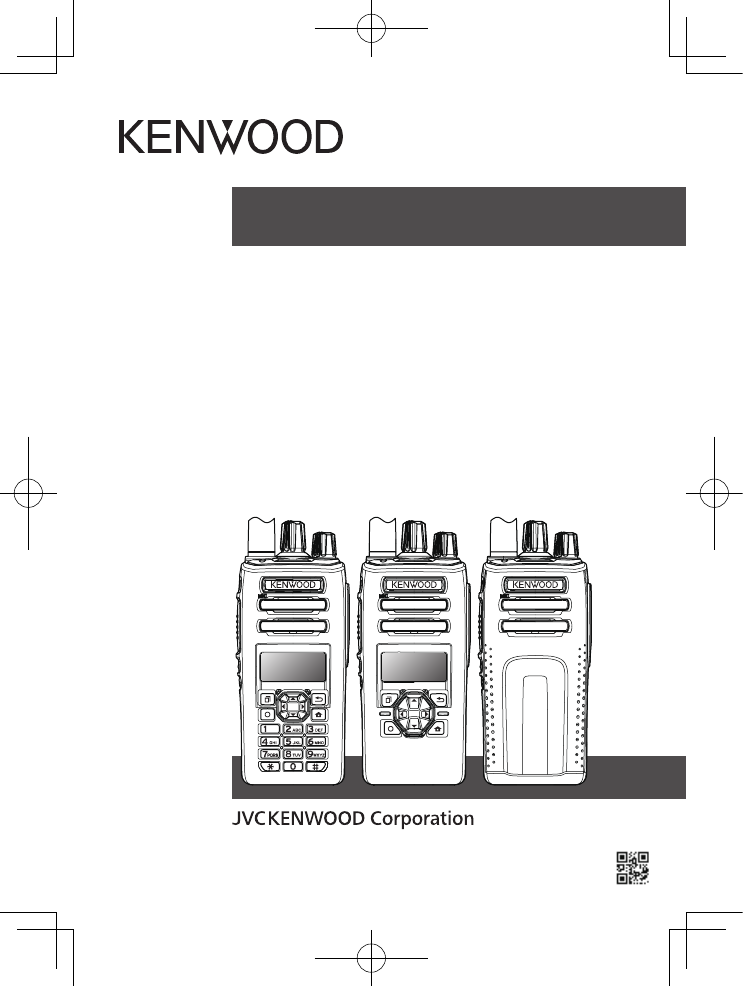
USER GUIDE
GUIDE DE L'UTILISATEUR
GUIA DEL USUARIO
NX-3000 series
B5A-2071-00 (K)
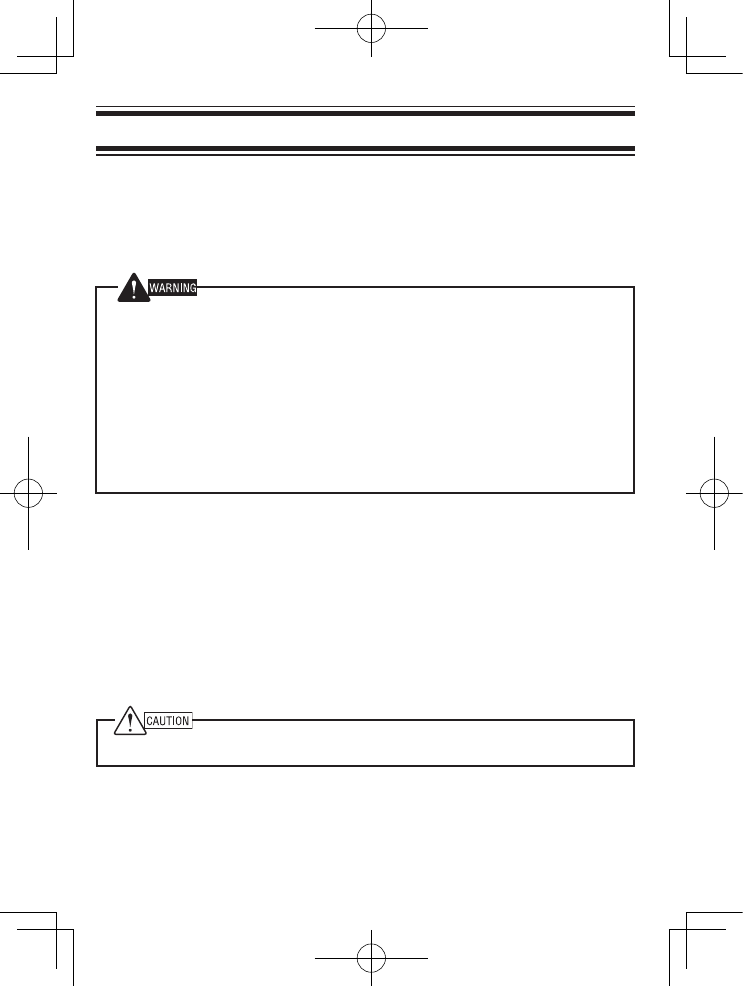
Radio FRequency eneRgy SaFety inFoRmation
This KENWOOD transceiver has been tested and complies with the standards listed below, in regards to
Radio Frequency (RF) energy and electromagnetic energy (EME) generated by the transceiver.
• FCC RF exposure limits for Occupational Use Only. RF Exposure limits adopted by the FCC are
generally based on recommendations from the National Council on Radiation Protection and
Measurements, & the American National Standards Institute.
• FCCOETBulletin65Edition97-01SupplementC
• AmericanNationalStandardsInstitute(C95.1–1992)
• AmericanNationalStandardsInstitute(C95.3–1992)
This KENWOOD transceiver generates RF EME while transmitting. RF EME (Radio Frequency Electric
&MagneticEnergy)hasthepotentialtocauseslightthermal,orheatingeectstoanypartofyourbody
less than the recommended distance from this radio transmitter’s antenna. RF energy exposure is
determined primarily by the distance to and the power of the transmitting device. In general, RF exposure
is minimized when the lowest possible power is used or transmission time is kept to the minimum
required for consistent communications, and the greatest distance possible from the antenna to the
bodyismaintained.Thetransceiverhasbeendesignedforandisclassiedfor
Occupational Use Only
.
Occupational/ controlled exposure limits are applicable to situations in which persons are exposed to RF
energy as a consequence of their employment, and such persons have been made aware of the potential
for exposure and can exercise control over their exposure. This means you can use the transceiver only
if you are aware of the potential hazards of operating a transceiver and are familiar in ways to minimize
these hazards. This transceiver is not intended for use by the general public in uncontrolled environments.
Uncontrolled environment exposure limits are applicable to situations in which the general public may be
exposed to RF energy, or in which the persons who are exposed as a consequence of their employment
may not be fully aware of the potential for exposure or cannot exercise control over their exposure.
The following list provides you with the information required to ensure that you are aware of RF exposure
and of how to operate this transceiver so that the FCC RF exposure limitations are not exceeded.
• Whiletransmitting(holdingthePTTswitchorspeakingwithVOXenabled),alwayskeepthe
antennaandtheradioatleast3cm(13/16inches)fromyourbodyorface,aswellasfromany
bystanders. A LED on the top of the radio shows red when the transmitter is operating in both
PTTandVOXmodes.
• Donottransmitformorethan50%ofthetotaltransceiverusetime;transmittingover50%ofthe
total use time may exceed the limits in accordance to the FCC RF exposure requirements. Nominal
transceiveroperationis5%transmissiontime,5%receptiontime,and90%stand-bytime.
• Useonlythespeciedantennaforthistransceiver;thismaybeeithertheantennaprovidedwith
the transceiver or another antenna authorized by KENWOOD.
Use only KENWOOD authorized accessories (antennas, battery packs, belt clips, Speaker/ Mics or
headsetsetc.):Whenwornonthebody,alwaysplacetheradioinaKENWOOD recommended clip
orcarryingcasemeantforthisproduct.Theuseofotherthanrecommendedorapprovedbody-worn
accessories may result in RF exposure levels which exceed the FCC’s occupational/ controlled
environment RF exposure limits.
To ensure that your exposure to RF EME is within the FCC limits for occupational use, you must
observe and adhere to the above points.
Electromagnetic Interference Compatibility
Electronic devices are susceptible to electromagnetic interference (EMI) if they are not adequately
shieldedordesignedforelectromagneticcompatibility.BecausethistransceivergeneratesRFenergy,it
can cause interference to such equipment.
• TurnOFFyourtransceiverwheresignsarepostedtodoso.Hospitalsandhealthcarefacilitiesuse
equipment that is sensitive to electromagnetic radiation.
• TurnOFFyourtransceiverwhileonboardanaircraftwhensoinstructed.Useofthetransceiver
must be in accordance with airline regulations and/or crew instructions.
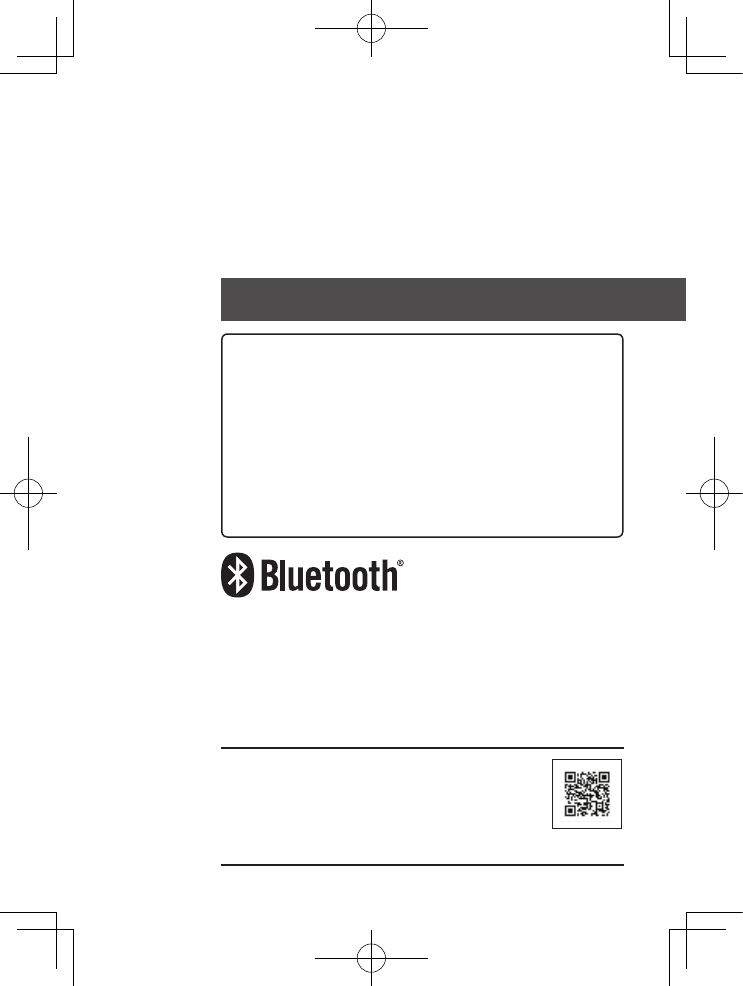
USER GUIDE
VHF DIGITAL TRANSCEIVER
NX-3200/ NX-3220
UHF DIGITAL TRANSCEIVER
NX-3300/ NX-3320
The AMBE+2TM voice coding Technology embodied in
this product is protected by intellectual property rights
including patent rights, copyrights and trade secrets of
Digital Voice Systems, Inc. This voice coding Technology
is licensed solely for use within this Communications
Equipment. The user of this Technology is explicitly
prohibited from attempting to extract, remove, decompile,
reverse engineer, or disassemble the Object Code, or in
any other way convert the Object Code into a human-
readable form. U.S. Patent Nos. #8,315,860, #8,595,002,
#6,199,037, #6,912,495, #8,200,497, #7,970,606, and
#8,359,197.
The Bluetooth® word mark and logo are registered trademarks
owned by the Bluetooth SIG, Inc. and any use of such marks by
JVC KENWOOD Corporation is under license. Other trademarks
and trade names are those of their respective owners.
Firmware Copyrights
The title to and ownership of copyrights for firmware
embedded in KENWOOD product memories are reserved for
JVC KENWOOD Corporation.
This User Guide covers only the basic
operations of your radio. Ask your dealer for
information on anycustomized features they
may have added to your radio. For using
details User Manual, refer to the following URL.
http://manual.kenwood.com/en_contents/search/keyword

2
THANK YOU
We are grateful you have chosen KENWOOD for your Digital
Transceiver applications.
Contents
notiCes to the User.................................................. 3
PreCaUtions ............................................................ 5
terMinaL DesCriPtions ............................................ 12
UnPaCKinG anD CheCKinG eQUiPMent ........................... 13
Supplied AcceSSorieS ........................................................................ 13
PreParation ........................................................... 14
inStAlling/ removing the (optionAl) BAttery pAck ................... 14
inStAlling/ removing AlkAline BAtterieS (optionAl BAttery
cASe) ....................................................................................................... 15
inStAlling the (optionAl) AntennA ................................................ 16
inStAlling the Belt clip .................................................................... 16
inStAlling the cAp over the univerSAl connector
<nX-3200/ nX-3300> ............................................................................... 17
inStAlling the (optionAl) SpeAker/ microphone or
heAdSet<nX-3200/ nX-3300> ............................................................... 17
inStAlling the cAp over the SpeAker/ microphone
JAckS<nX-3220/ nX-3320> .................................................................... 18
inStAlling the (optionAl) SpeAker/ microphone
<nX-3220/ nX-3320> ............................................................................... 18
orientation ............................................................ 19
ButtonS And controlS ...................................................................... 19
diSplAy .................................................................................................. 22
BasiC oPerations .................................................... 25
Switching power on/ oFF .................................................................. 25
AdJuSting the volume ....................................................................... 25
Selecting A Zone And chAnnel ........................................................ 25
trAnSmitting ....................................................................................... 26
receiving ............................................................................................... 26
inForMation on soFtWare LiCense .............................27
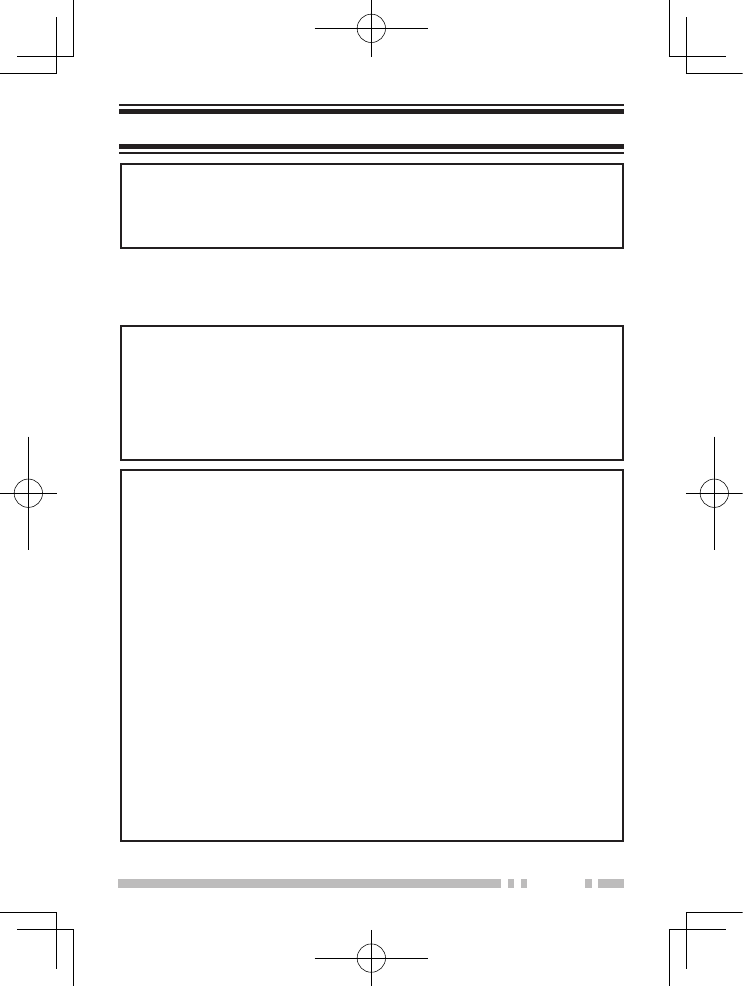
3
notiCes to the User
• Government law prohibits the operation of unlicensed radio
transmitters within the territories under government control.
• Illegal operation is punishable by fine and/or imprisonment.
• Refer service to qualified technicians only.
Safety: It is important that the operator is aware of and
understands hazards common to the operation of any transceiver.
One or more of the following statements may be applicable:
FCC WARNING
This equipment generates or uses radio frequency energy.
Changes or modifications to this equipment may cause harmful
interference unless the modifications are expressly approved by
the party responsible/ JVC KENWOOD. The user could lose the
authority to operate this equipment if an unauthorized change or
modification is made.
INFORMATION TO THE DIGITAL DEVICE USER REQUIRED BY
THE FCC
This equipment has been tested and found to comply with the limits
for a Class B digital device, pursuant to Part 15 of the FCC Rules.
These limits are designed to provide reasonable protection against
harmful interference in a residential installation.
This equipment generates, uses and can generate radio
frequency energy and, if not installed and used in accordance
with the instructions, may cause harmful interference to radio
communications. However, there is no guarantee that the
interference will not occur in a particular installation. If this equipment
does cause harmful interference to radio or television reception,
which can be determined by turning the equipment off and on, the
user is encouraged to try to correct the interference by one or more of
the following measures:
• Reorientorrelocatethereceivingantenna.
• Increasetheseparationbetweentheequipmentandreceiver.
• Connecttheequipmenttoanoutletonacircuitdifferentfrom
that to which the receiver is connected.
• Consultthedealerfortechnicalassistance.
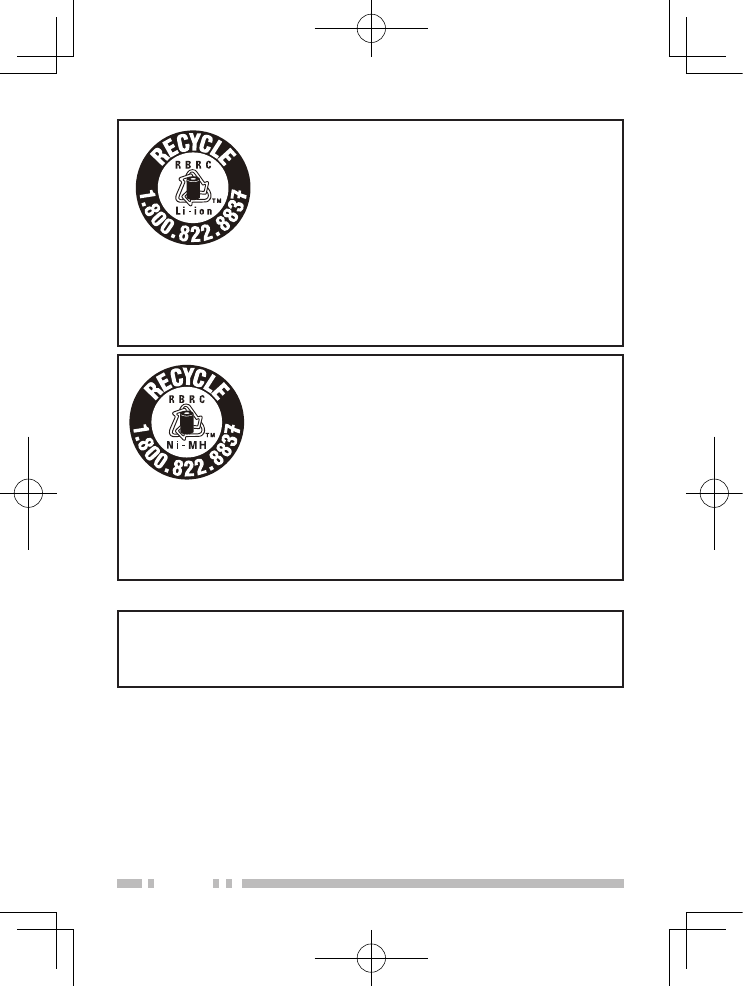
4
ATTENTION:
The RBRC Recycle seal found on KENWOOD
lithium-ion (Li-ion) battery packs indicates
KENWOOD’s voluntary participation in an industry
program to collect and recycle Li-ion batteries after
their operating life has expired. The RBRC program
is an alternative to disposing Li-ion batteries with
your regular refuse or in municipal waste streams,
which is illegal in some areas.
For information on Li-ion battery recycling in your area, call (toll free)
1-800-8-BATTERY (1-800-822-8837).
KENWOOD’s involvement in this program is part of our commitment to
preserve our environment and conserve our natural resources.
ATTENTION:
The RBRC Recycle seal found on KENWOOD
nickel
metal hydride (Ni-MH) battery packs indicates
KENWOOD’s
voluntary participation in an industry
program to collect and recycle Ni-MH batteries after
their operating life has expired. The RBRC program is
an alternative to disposing Ni-MH batteries with your
regular refuse or in municipal waste streams, which
is illegal in some areas.
For information on
Ni-MH
battery recycling in your area, call (toll free)
1-800-8-BATTERY (1-800-822-8837).
KENWOOD’s involvement in this program is part of our commitment to
preserve our environment and conserve our natural resources.
This device complies with Industry Canada licence-exempt RSS standard(s).
Operation is subject to the following two conditions: (1) this device may not
cause interference, and (2) this device must accept any interference, including
interference that may cause undesired operation of the device.

5
PreCaUtions
• Donotchargethetransceiverandbatterypackwhentheyarewet.
• Ensurethattherearenometallicitemslocatedbetweenthe
transceiver and the battery pack.
• DonotuseoptionsnotspeciedbykEnWooD.
• Ifthedie-castchassisorothertransceiverpartisdamaged,donot
touch the damaged parts.
• Ifaheadsetorheadphoneisconnectedtothetransceiver,reduce
the transceiver volume. Pay attention to the volume level when
turning the squelch off.
• Donotplacethemicrophonecablearoundyourneckwhilenear
machinery that may catch the cable.
• Donotplacethetransceiveronunstablesurfaces.
• Ensurethattheendoftheantennadoesnottouchyoureyes.
• Whenthetransceiverisusedfortransmissionformanyhours,the
radiator and chassis will become hot. Do not touch these locations
when replacing the battery pack.
• Whenwatergetsintothemicrophoneopeningorthespeaker
grill, the voice level may become incoherent or distorted. Lightly
shake the transceiver to remove the water from the speaker and/or
microphone before operating the transceiver.
• Alwaysswitchthetransceiverpoweroffbeforeinstallingoptional
accessories.
• ThechargeristhedevicethatdisconnectstheunitfromtheAC
mains line. The AC plug should be readily accessible.
• Todisposeofbatteries,besuretocomplywiththelawsand
regulations in your country or region.
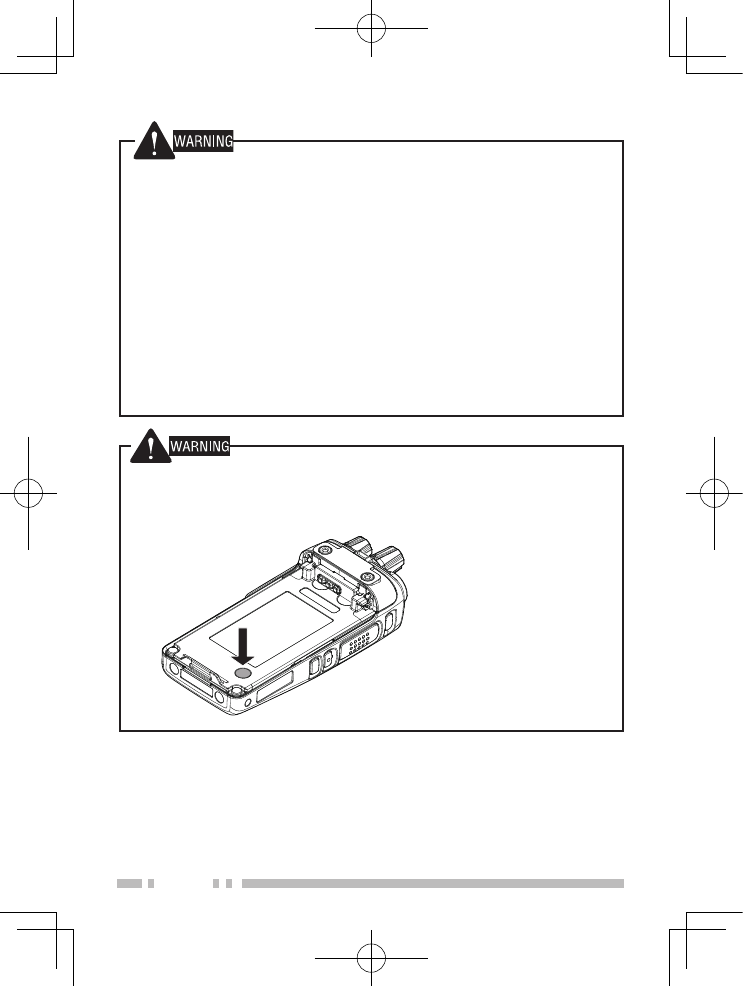
6
Turn the transceiver power off before entering the following locations:
•Near explosives or blasting sites.
•In aircrafts. (Any use of the transceiver must follow the
instructions and regulations provided by the airline crew.)
•Where restrictions or warnings are posted regarding the use of
radio devices, including but not limited to medical facilities.
•Near persons wearing pacemakers.
Turn the transceiver power off before entering the following
locations, unless the model is specifically qualified for such use
(Intrinsically Safe such as approved by CSA):
•In explosive atmospheres (inflammable gas, dust particles,
metallic powders, grain powders, etc.).
•While pumping on fuel or while parked at gasoline service stations.
•Do not remove the black sheet from the reverse side of the
transceiver (refer to the illustration below). Removal of this
sheet decreases the waterproof efficiency of the transceiver
and may cause malfunctions if water seeps into the transceiver.
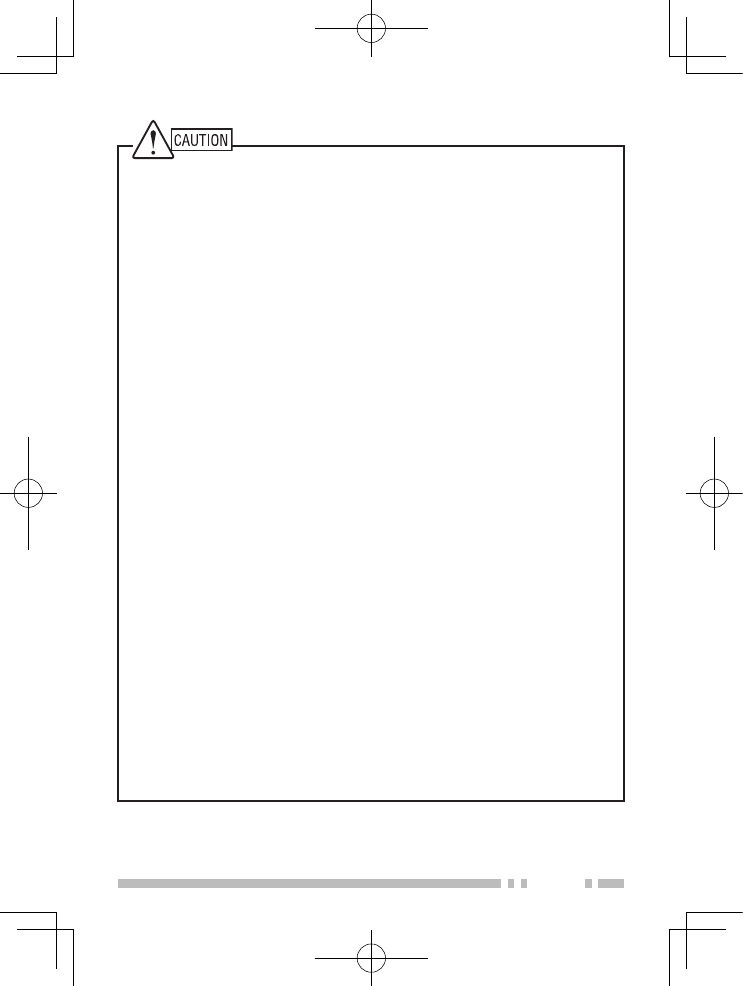
7
•Do not disassemble or modify the transceiver for any reason.
•Do not place the transceiver on or near airbag equipment while
the vehicle is running. When the airbag inflates, the transceiver
may be ejected and strike the driver or passengers.
•Do not transmit while touching the antenna terminal or if
any metallic parts are exposed from the antenna covering.
Transmitting at such a time may result in a high-frequency burn.
•If an abnormal odor or smoke is detected coming from the
transceiver, switch the transceiver power off immediately,
remove the battery pack from the transceiver, and contact your
KENWOOD dealer.
•Use of the transceiver while you are driving may be against
traffic laws. Please check and observe the vehicle regulations
in your area.
•Do not expose the transceiver to extremely hot or cold
conditions.
•Do not carry the battery pack (or battery case) with metal
objects, as they may short the battery terminals.
•Danger of explosion if the battery is incorrectly replaced;
replace only with the same type.
•When attaching a commercial strap to the transceiver,
ensure that the strap is durable. In addition, do not swing the
transceiver around by the strap; you may inadvertently strike
and injure another person with the transceiver.
•If a commercially available neck strap is used, take care not to
let the strap get caught on nearby machine.
•When operating the transceiver in areas where the air is dry, it
is easy to build up an electric charge (static electricity).
When using an earphone accessory in such conditions, it is
possible for the transceiver to send an electric shock through
the earphone and to your ear. We recommend you use only
a speaker/microphone in these conditions, to avoid electric
shocks.
•Do not expose the transceiver to long periods of direct sunlight,
nor place it near heating appliances.
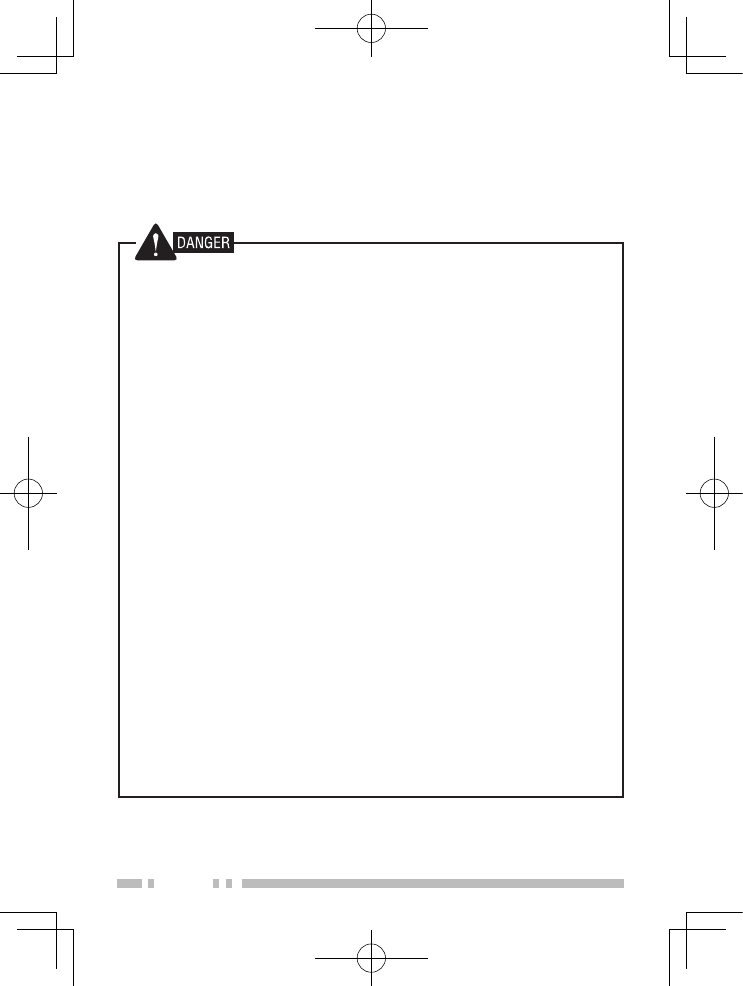
8
Information concerning the battery pack:
The battery pack includes flammable objects such as organic solvent.
Mishandling may cause the battery to rupture producing flames or
extreme heat, deteriorate, or cause other forms of damage to the
battery. Please observe the following prohibitive matters.
•Do not disassemble or reconstruct battery!
The battery pack has a safety function and protection circuit to
avoid danger. If they suffer serious damage, the battery may
generate heat or smoke, rupture, or burst into flame.
•Do not short-circuit the battery!
Do not join the + and – terminals using any form of metal (such
as a paper clip or wire). Do not carry or store the battery pack
in containers holding metal objects (such as wires, chain-
necklace or hairpins). If the battery pack is short-circuited,
excessive current will flow and the battery may generate heat
or smoke, rupture, or burst into flame. It will also cause metal
objects to heat up.
•Do not incinerate or apply heat to the battery!
If the insulator is melted, the gas release vent or safety function
is damaged, or the electrolyte is ignited, the battery may
generate heat or smoke, rupture, or burst into flame.
•Do not leave the battery near fires, stoves, or other heat
generators (areas reaching over 80°C/ 176°F)!
If the polymer separator is melted due to high temperature,
an internal short-circuit may occur in the individual cells and
the battery may generate heat or smoke, rupture, or burst into
flame.
•Avoid immersing the battery in water or getting it wet by
other means!
If the battery becomes wet, wipe it off with a dry towel before
use. If the battery’s protection circuit is damaged, the battery
may charge at extreme current (or voltage) and an abnormal
chemical reaction may occur. The battery may generate heat or
smoke, rupture, or burst into flame.
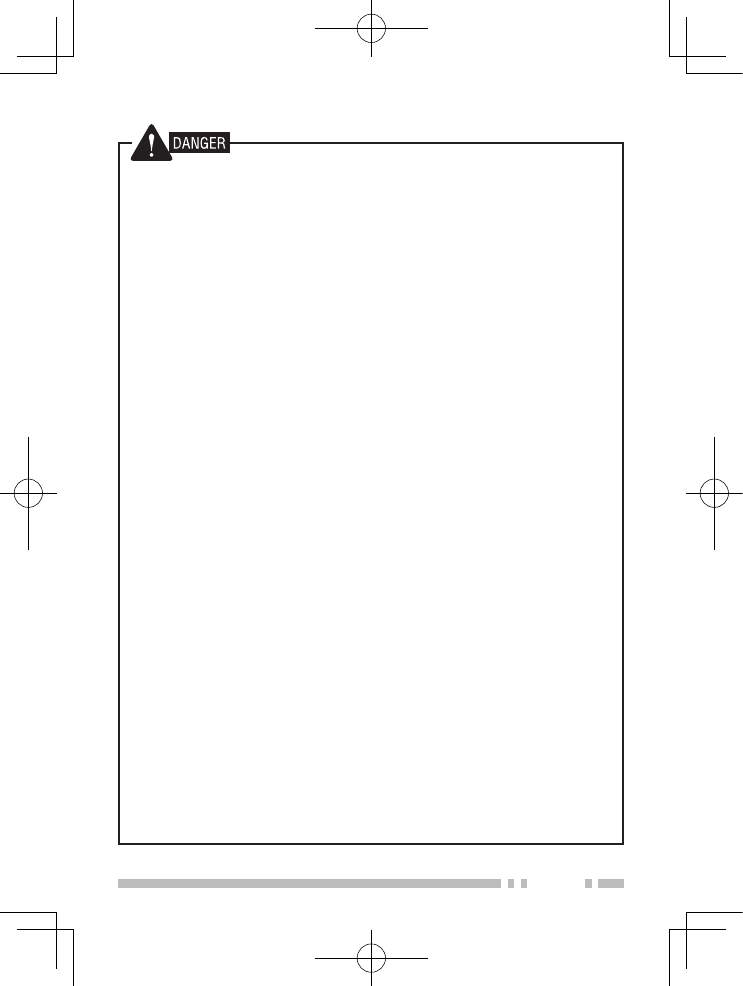
9
•Do not charge the battery near fires or under direct
sunlight!
If the battery’s protection circuit is damaged, the battery
may charge at extreme current (or voltage) and an abnormal
chemical reaction may occur. The battery may generate heat or
smoke, rupture, or burst into flame.
•Use only the specified charger and observe charging
requirements!
If the battery is charged in unspecified conditions (under high
temperature over the regulated value, excessive high voltage or
current over regulated value, or with a remodelled charger), it
may overcharge or an abnormal chemical reaction may occur.
The battery may generate heat or smoke, rupture, or burst into
flame.
•Do not pierce the battery with any object, strike it with an
instrument, or step on it!
This may break or deform the battery, causing a short-circuit.
The battery may generate heat or smoke, rupture, or burst into
flame.
•Do not jar or throw the battery!
An impact may cause the battery to leak, generate heat
or smoke, rupture, and/or burst into flame. If the battery’s
protection circuit is damaged, the battery may charge at an
abnormal current (or voltage), and an abnormal chemical
reaction may occur.
•Do not use the battery pack if it is damaged in any way!
The battery may generate heat or smoke, rupture, or burst into
flame.
•Do not solder directly onto the battery!
If the insulator is melted or the gas release vent or safety
function is damaged, the battery may generate heat or smoke,
rupture, or burst into flame.
•Do not reverse the battery polarity (and terminals)!
When charging a reversed battery, an abnormal chemical
reaction may occur. In some cases, an unexpected large
amount of current may flow upon discharging. The battery may
generate heat or smoke, rupture, or burst into flame.
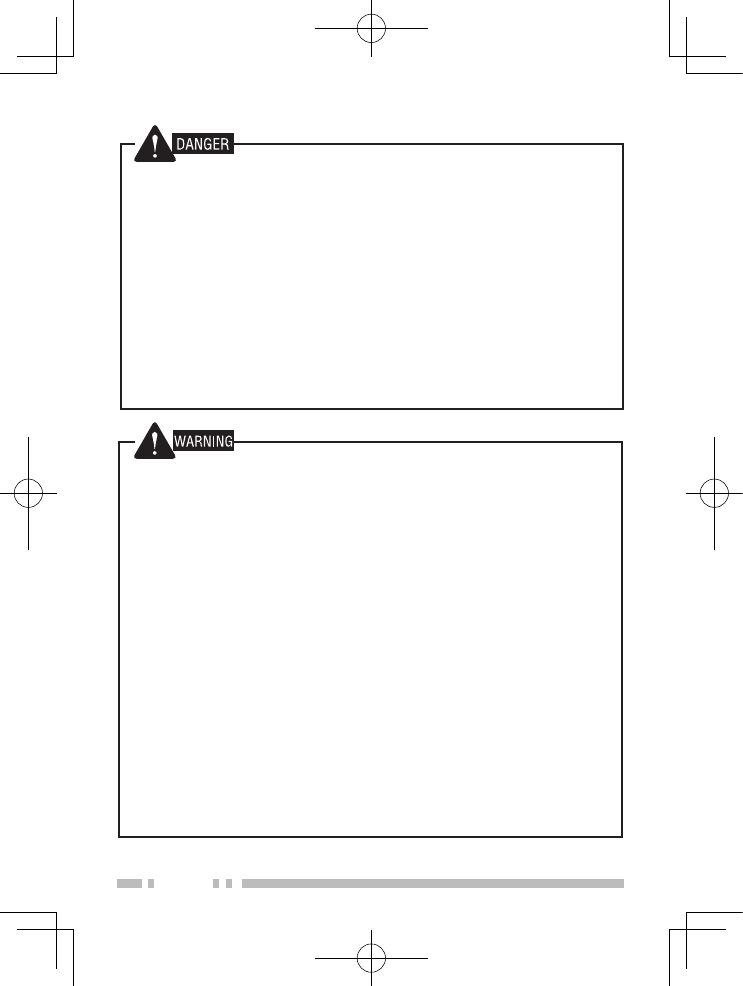
10
•Do not reverse-charge or reverse-connect the battery!
The battery pack has positive and negative poles. If the battery
pack does not smoothly connect with a charger or operating
equipment, do not force it; check the polarity of the battery. If
the battery pack is reverse-connected to the charger, it will be
reverse-charged and an abnormal chemical reaction may occur.
The battery may generate heat or smoke, rupture, or burst into
flame.
•Do not touch a ruptured and leaking battery!
If the electrolyte liquid from the battery gets into your eyes,
wash your eyes out with fresh water as soon as possible,
without rubbing your eyes. Go to the hospital immediately. If
left untreated, it may cause eye-problems.
•Do not charge the battery for longer than the specified
time!
If the battery pack has not finished charging even after the
regulated time has passed, stop it. The battery may generate
heat or smoke, rupture, or burst into flame.
•Do not place the battery pack into a microwave or high
pressure container!
The battery may generate heat or smoke, rupture, or burst into
flame.
•Keep ruptured and leaking battery packs away from fire!
If the battery pack is leaking (or the battery emits a bad odor),
immediately remove it from flammable areas. Electrolyte
leaking from battery can easily catch on fire and may cause the
battery to generate smoke or burst into flame.
•Do not use an abnormal battery!
If the battery pack emits a bad odor, appears to have color
changes, is deformed, or seems abnormal for any other reason,
remove it from the charger or operating equipment and do not
use it. The battery may generate heat or smoke, rupture, or
burst into flame.

11
notiFiCation oF Water-resistant MoDeL
Water Resistance and Maintenance
Water-Resistant Model transceiver conforms to the following standards.
IP67: The IP standard is the protection level specified by the international
standard IEC 60529. The first numeral indicates the "dust-resistant level"
and the second numeral indicates the "water-resistant" level.
Note:
•Initial water-resistant tests and procedures are performed
products upon being ordered from KENWOOD.
PreCaUtions
• Theapplicablestandardslistedabovedonotassurethatthe
transceiver can be used in water. The transceiver may be damaged
in a situation in which the maximum depth is over 1 meter or the
maximum submersion time exceeds 30 minutes.
• Observe the following precautions to maintain the transceiver’s
water-resistant performance:
a) Do not drop or apply strong physical shocks to the transceiver.
b) Do not disassemble or attempt to modify the transceiver. (If it is
disassembled or modified, its performance is not guaranteed.)
c) Do not soak the transceiver in water that contains a solvent or
surfactant, such as detergent or alcohol.
• If it is soaked in muddy water or salt water (including sea water),
it may become corroded. Immediately flush with fresh water and
then wipe dry with a soft cloth.
• Ifwaterissplashedontothemicrophone,thebattery,orthe
antenna terminal, clean and dry them with a soft cloth before
reconnecting to the transceiver.
• Whenwatergetsintothemicrophoneopeningorthespeaker
grill, the voice level may become low or distorted. Lightly shake
the transceiver to remove the water from the speaker and/or
microphone before operating the transceiver.
•
Use of any option on the transceiver not specified by KENWOOD, may
reduce or void the water resistant and dust resistant performance.
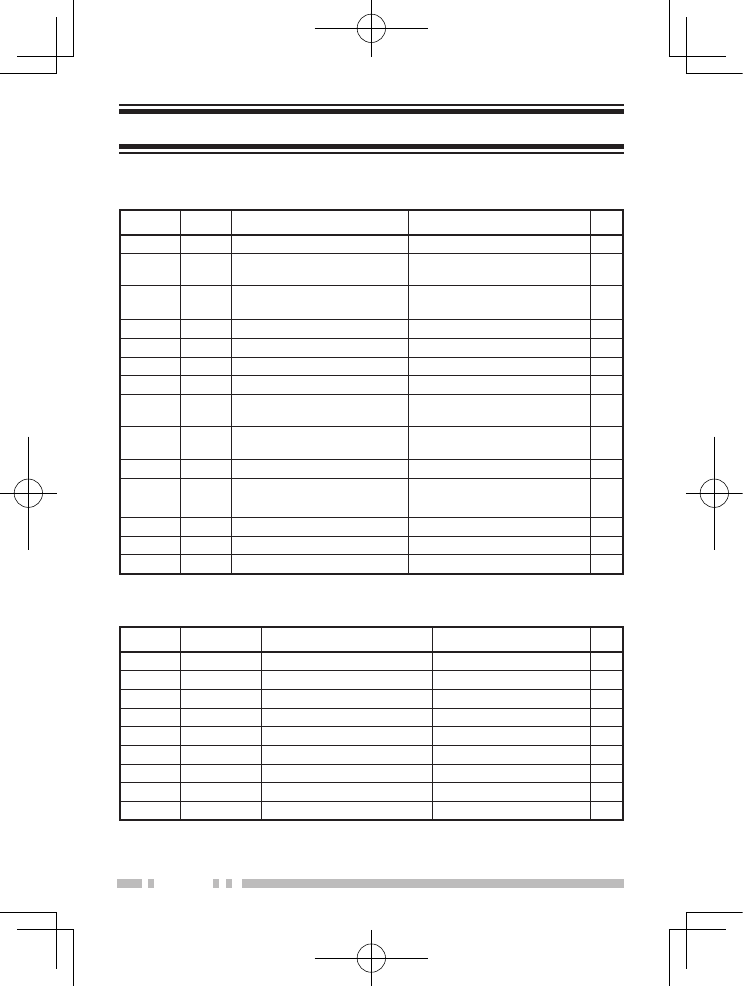
12
terMinaL DesCriPtions
Universal connector (NX-3200/ NX-3300)
It is possible to use a resin-based cover for the Universal connector.
Pin No. Name Description Specification I/O
1 SSW Ext/ Int Speaker Switch Input Hi: INT, Low: EXT I
2 SP+ BTL Output + for External
Speaker Standard load 8 ΩO
3 SP- BTL Output – for External
Speaker Standard load 8 ΩO
4 MSW Ext/ Int MIC Switch Input Hi: INT, Low: EXT I
5 EMC External MIC Input Impedance: 2.2 kΩI
6 ME External MIC GND -
7 PTT External PTT Input Low: PTT ON I
8 PF Programmable Function
Button Input Input voltage: 0 V - 5.0 V I
9 OPT Aux I/O Port (for EXT Option) I: 0 V - 5.0 V
O: Standard load 25 kΩI/O
10 E GND GND
11 5V 5 V 5 V power supply output
Max output current: 140 mA O
12 TXD Serial Data Output Baud rate: 1.152 Mbps max O
13 RXD Serial Data Input Baud rate: 1.152 Mbps max I
14 EMC External MIC input Impedance: 2.2 kΩI
Speaker/ Microphone Jacks (NX-3220/ NX-3320)
It is possible to use a resin-based cover for the Speaker/ Microphone jacks.
Pin No. Name Description Impedance I/O
1 PTT/RXD PTT input / Serial data input 2.7 kΩI
2 MICI MIC input 2.2 kΩI
3 NC No connection − −
4 OPTDET Option Detect 74 kΩI
5 50J 5V output −O
6 AE Audio Earth GND −
7 TXD Serial data output 10 kΩO
8 EXTSPDET External speaker detection − −
9 SPO AF power output −O
Antenna Terminal
50 Ω impedance

13
UnPaCKinG anD CheCKinG eQUiPMent
Note:
•The following unpacking instructions are for use by your
KENWOOD dealer, an authorized KENWOOD service facility, or
the factory.
Carefully unpack the transceiver. We recommend that you
identify the items listed in the following table before discarding
the packing material. If any items are missing or have
been damaged during shipment, file a claim with the carrier
immediately.
sUPPLieD aCCessories
Belt clip ................................................ 1
• Screwsforbeltclip(M3x8mm) .......................... 2
Universal connector cap <NX-3200/ NX-3300 only> .............. 1
Speaker/ microphone jacks cap <NX-3220/ NX-3320 only> ........ 1
Speaker/ microphone locking bracket <NX-3220/ NX-3320 only>. . . . 1
Stopper <Full Button Model and Standard Button Model only> .....1
Users Guide ............................................1
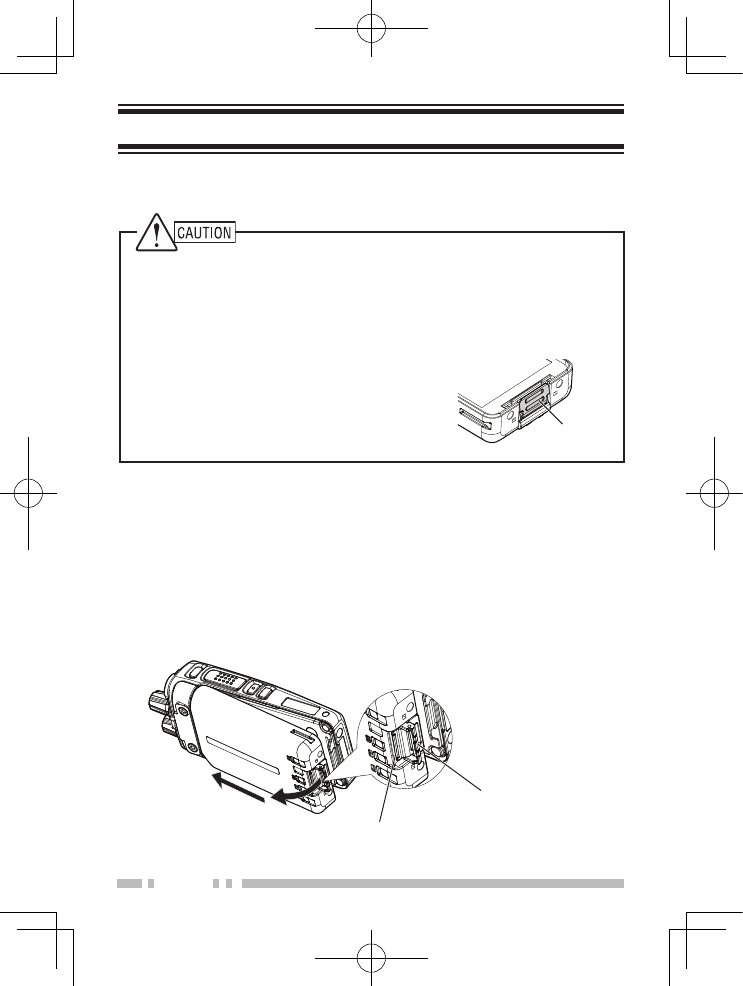
14
PreParation
instaLLinG/ reMovinG the (oPtionaL) Battery
PaCK
•Do not short the battery terminals or dispose of the battery by fire.
•Never attempt to remove the casing from the battery pack.
•Install the battery pack after cleaning the battery pack contacts and
the transceiver terminals.
•Before charging a battery pack that is attached to the transceiver,
ensure that the safety catch is firmly closed.
•If the release latch is tilted and the battery
pack is not attached to the transceiver, return
the release latch to its original position using
your finger.
1 Match the guides of the battery pack with the corresponding
grooves on the upper rear of the transceiver, then firmly
press the battery pack to lock it in place.
2 Lock the safety catch to prevent accidentally pressing the
release latch and removing the battery pack.
3 To remove the battery pack, lift the safety catch, press the
release latch, then pull the battery pack away from the
transceiver.
2
13
Release latch
Safety catch
Release latch
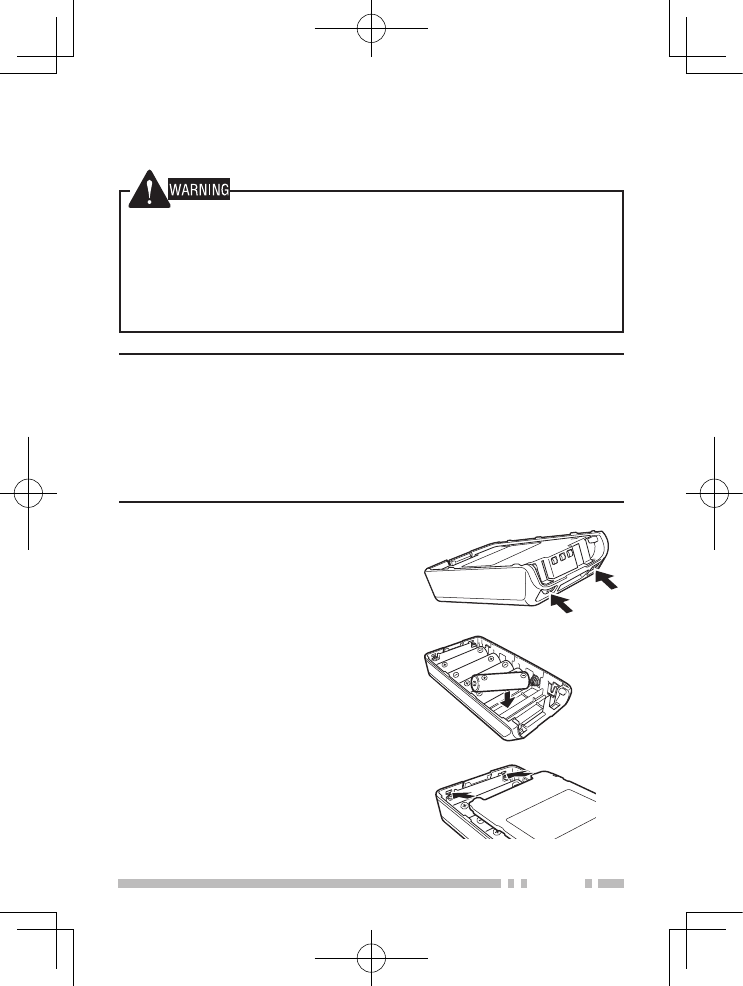
15
instaLLinG/ reMovinG aLKaLine Batteries
(oPtionaL Battery Case)
◆ Do not install batteries in a hazardous environment where
sparks could cause an explosion.
◆ Never discard batteries in fire; extremely high temperatures can
cause batteries to explode.
◆ Do not short circuit the battery case terminals.
◆ Do not use rechargeable batteries.
Note:
◆ If you do not plan to use the transceiver for a long period,
remove the batteries from the battery case.
◆ This battery case has been designed for transmitting at a
power of approximately 1 W (the low power setting on your
transceiver). If you want to transmit a stronger signal (using
the high power setting on your transceiver), use an optional
rechargeable battery pack.
1 To open the battery case, press
on the two tabs on the upper
rear of the case, then pull the
two halves apart.
2 Insert 6 AA (LR6) Alkaline
batteries into the battery case.
• Besuretomatchthepolarities
with those marked in the
bottom of the battery case.
3 Align the tabs of the cover with
the base, then push down on
the cover until it locks in place.
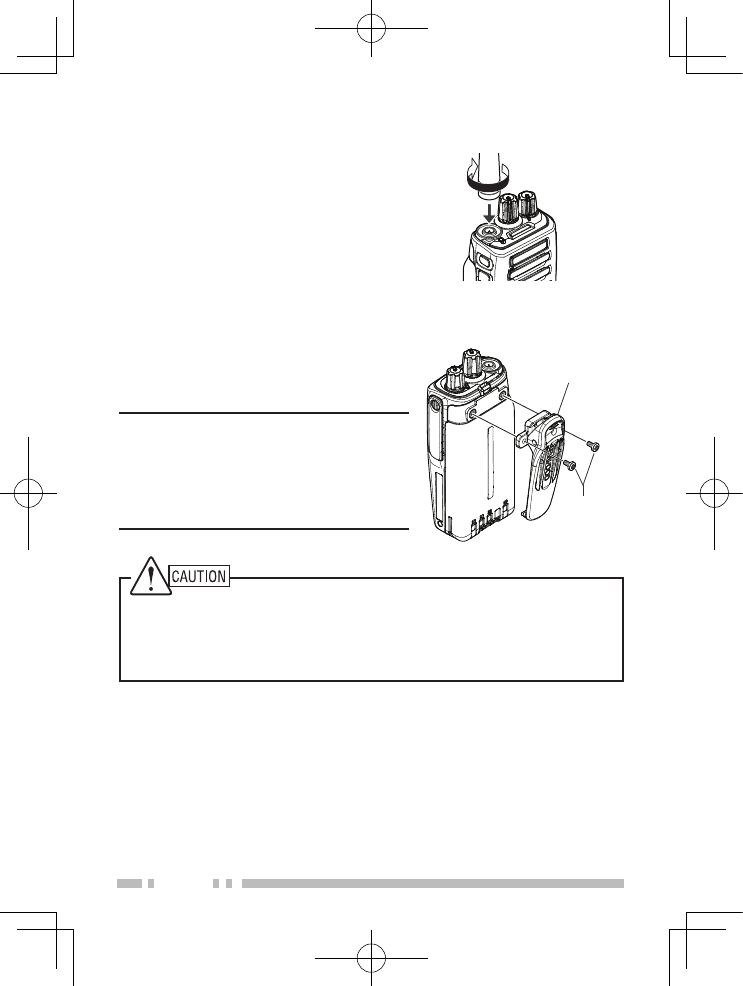
16
instaLLinG the (oPtionaL) antenna
Screw the antenna into the connector
on the top of the transceiver by holding
the antenna at its base and turning it
clockwise until secure.
Optional
antenna
instaLLinG the BeLt CLiP
If necessary, attach the belt clip
using the two supplied M3 x 8 mm
binding screws.
note:
•If the belt clip is not installed, its
mounting location may get hot
uring continuous transmission
or when left sitting in a hot
environment.
Belt clip
M3 x 8 mm
screws
Do not use glue which is designed to prevent screw loosening when
installing the belt clip, as it may cause damage to the transceiver.
Acrylic ester, which is contained in these glues, may crack the
transceiver’s back panel.
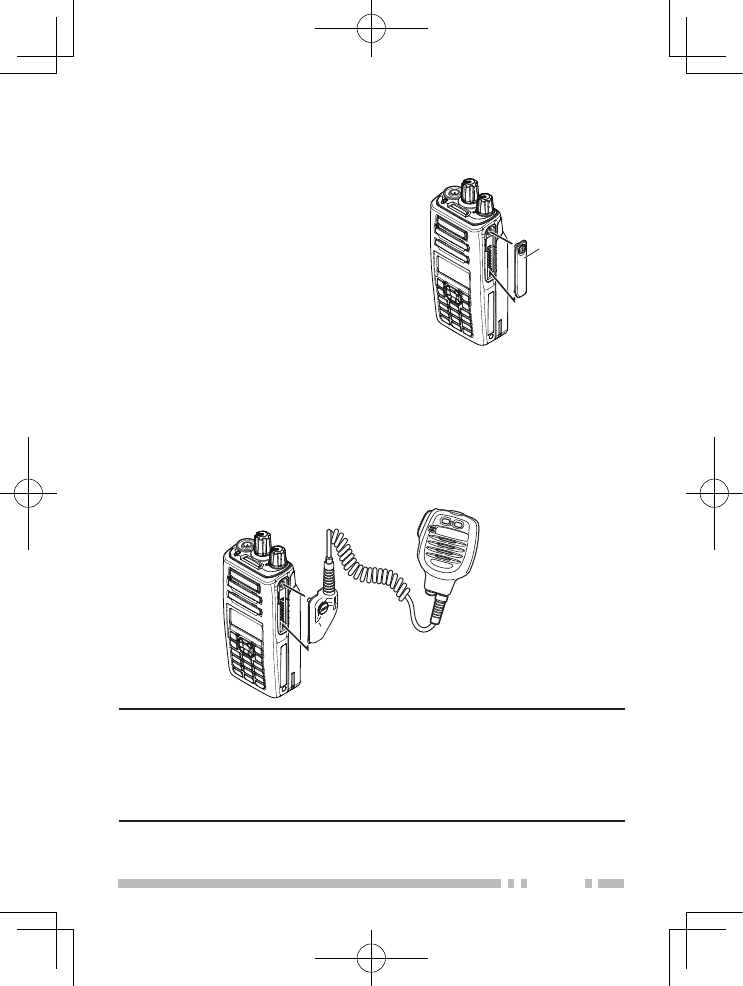
17
instaLLinG the CaP over the UniversaL
ConneCtor <nX-3200/ nX-3300>
1 If you are not using an optional
speaker/ microphone or headset,
install the cap over the universal
connector.
2 Secure the cap in place using
the dressing screw.
Universal
connector cap
instaLLinG the (oPtionaL) sPeaKer/ MiCroPhone
or heaDset <nX-3200/ nX-3300>
1 Insert the guide of the speaker/ microphone or headset
connector into the groove of the universal connector.
2 Secure the connector in place using the attached screw.
Optional speaker/
microphone
Note:
•When not using an optional speaker/ microphone or headset,
install the cap over the universal connector.
•The noise canceling function on KMC-54WD Speaker Microphone
works using the built-in DSP of the transceiver, and can only be used
with NX-3000 series Portable models.
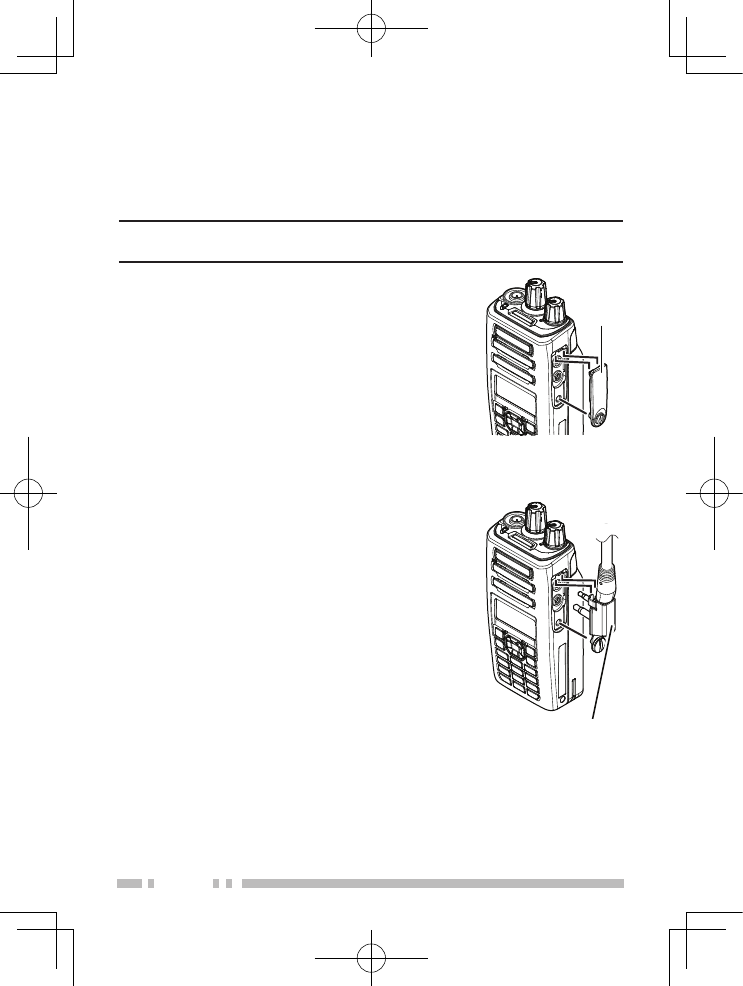
18
instaLLinG the CaP over the sPeaKer/
MiCroPhone JaCKs
<nX-3220/ nX-3320>
Install the cap over the speaker/ microphone jacks when not
using an optional speaker/ microphone.
note: To keep the transceiver water resistant, you must cover the
speaker/ microphone jacks with the supplied cap.
1 If you are not using an optional speaker/
microphone or headset, install the cap
over the
Speaker/ Microphone Jacks
.
2 Secure the cap in place using the
dressing screw.
instaLLinG the (oPtionaL) sPeaKer/
MiCroPhone <nX-3220/ nX-3320>
1 Insert the speaker/ microphone plugs
into the speaker/ microphone jacks of
the transceiver.
2 Place the locking bracket over the
speaker/ microphone plugs so that the
locking tabs insert into the transceiver
grooves.
3 Secure the locking bracket in place
using the dressing screw.
Speaker/
microphone
jacks cap
Speaker/ microphone
locking bracket
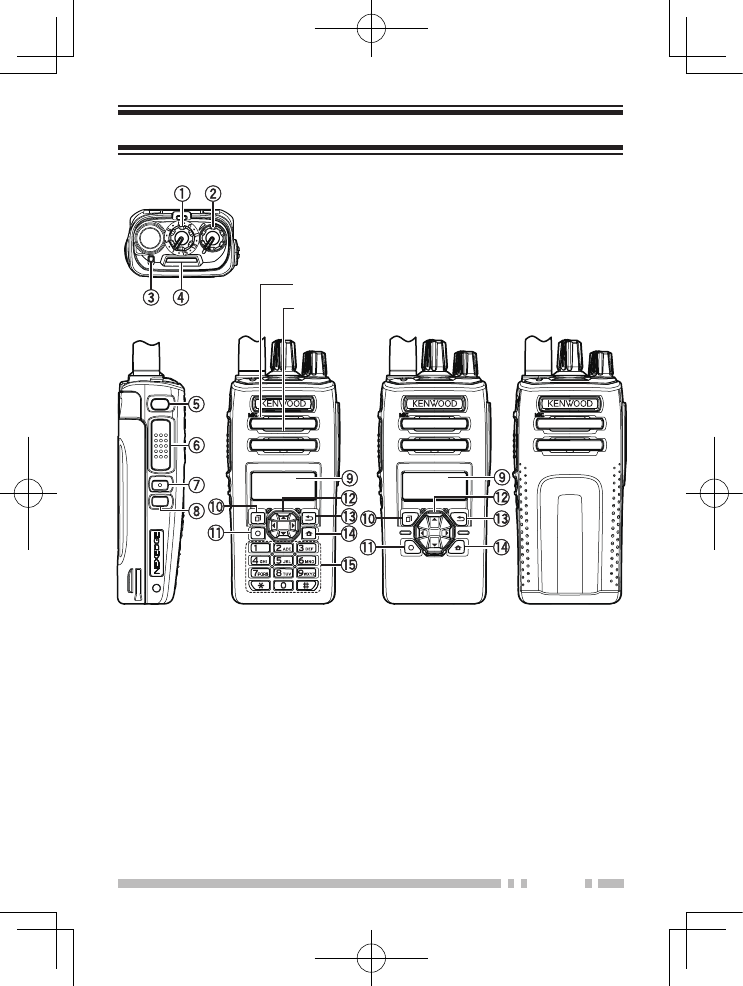
19
orientation
a Selector
Rotate this control to activate its programmable function.
The default setting is Channel Select.
b Power switch/ Volume control
Turn clockwise to switch the transceiver ON. To switch
the transceiver OFF, turn counterclockwise fully. Rotate to
adjust the volume level.
BUttons anD ControLs
Microphone
Speaker
Full Button Model Standard Button Model Basic Button Model
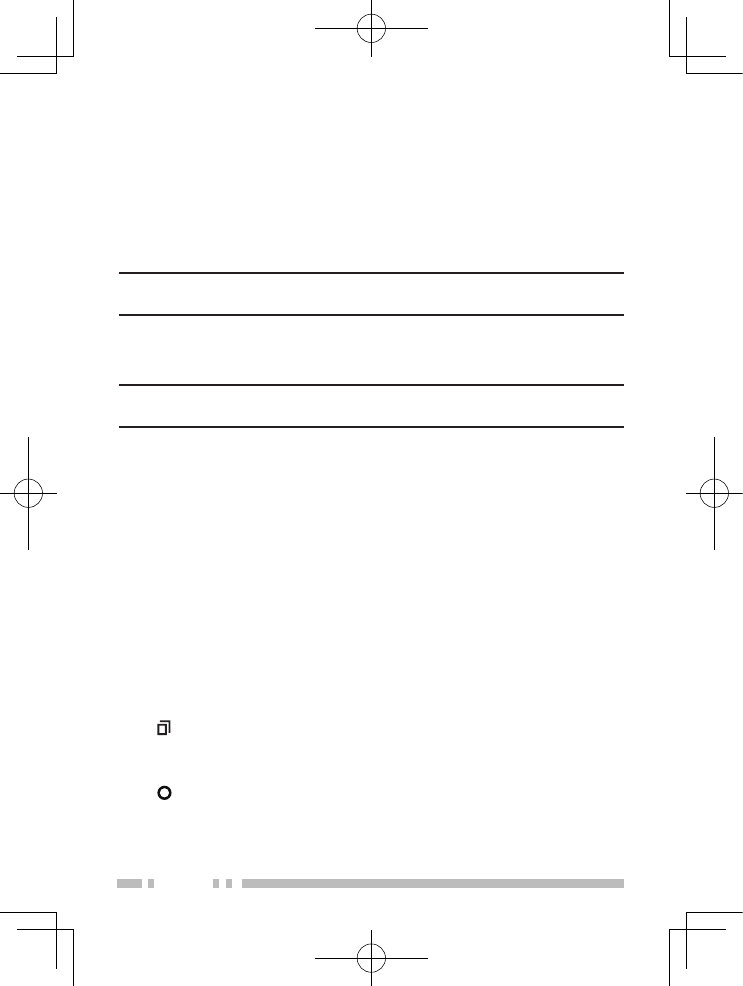
20
c Transmit/ Receive/ Battery low indicator
The indicator lights in different colors to indicate the current
status of the transceiver.
Lights red while transmitting and green while receiving.
Flashes red when the battery power is low while
transmitting. Replace or recharge the battery pack when the
battery power is low.
Note:
•This indicator can be disabled by your dealer.
d Light Bar
This Light Bar lights when selecting a channel or upon
reception.
Note:
•This indicator can be disabled by your dealer.
e Auxiliary (orange) button
Press to activate its programmable function.
f PTT (Push-To-Talk) switch
Press and hold, then speak into the microphone to call a
station.
g Side 1 button
Press to activate its programmable function. The default
button setting is [Squelch Off Momentary].
h Side 2 button
Press to activate its programmable function. The default
button setting is [Backlight].
i LCD Display
Refer to the display. {p. 20}
j [ ] button
Press to activate its programmable function. The default
button setting is [Menu].
k [ ] button
Press to activate its programmable function. The default
button setting is [Function].
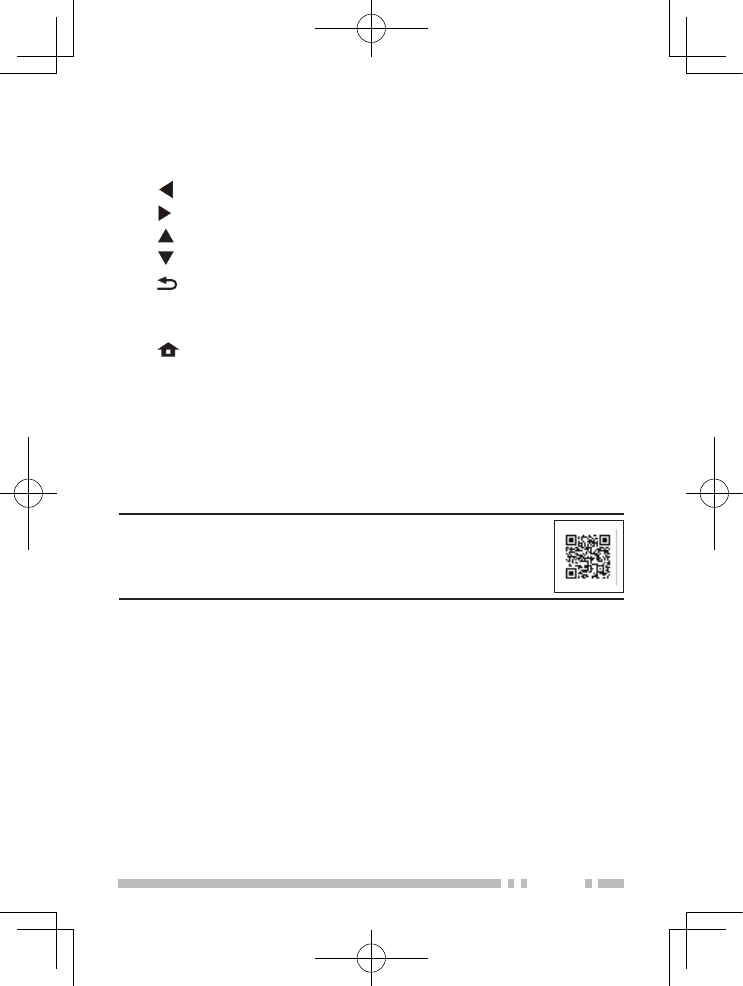
21
l 4-way D-pad (Full Button Model/ Standard Button
Model)
Press to activate its programmable function.
[ ] : The default setting is [None].
[ ] : The default setting is [None].
[ ] : The default setting is [Zone Up].
[ ] : The default setting is [Zone Down].
m [ ] button
Press to activate its programmable function. The default
button setting is [None].
n [ ] button
Press to activate its programmable function. The default
button setting is [Clear].
o Keypad (Full Button Model only)
The keypad buttons can also be programmed with
secondary functions if a programmable function buttons is
programmed as Function.
For details on programming functions to the buttons on
your transceiver, please contact your dealer or refer to the
instruction manual available from the following URL.
http://manual.kenwood.com/en_contents/search/keyword
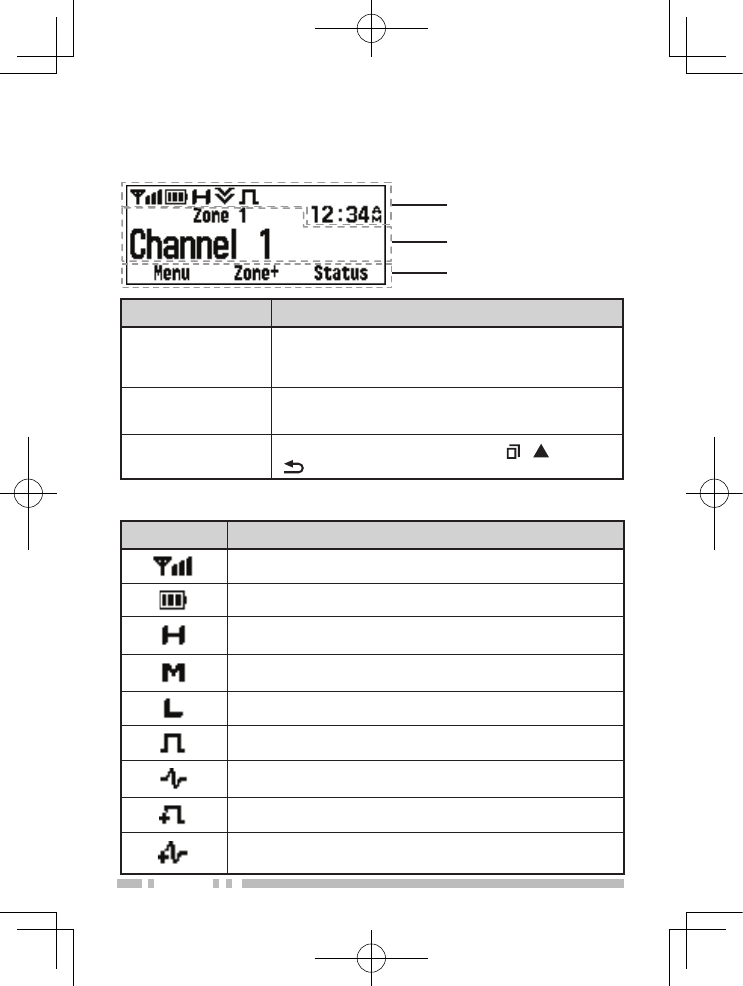
22
DisPLay
Display Area Description
Function Indicator
Area
Display the various function Icons ,signal
strength indicator and battery power indicator
and clock.
Main Area Display the information of the transceiver such
as Channel number and Zone number.
Button Guide Area Display the button functions for [ ],[ ] and
[ ].
Basic Frame
Function Indicator
Indicator Description
Displays the signal strength.
Displays the battery power.
The channel is using high transmit power.
The channel is using medium transmit power.
The channel is using low transmit power.
In Digital mode (Digital Channel)
In Analog mode (Analog Channel)
In Digital mode (Mixed Channel)
In Analog mode (Mixed Channel)
Function Indicator Area
Main Area
Button Guide Area
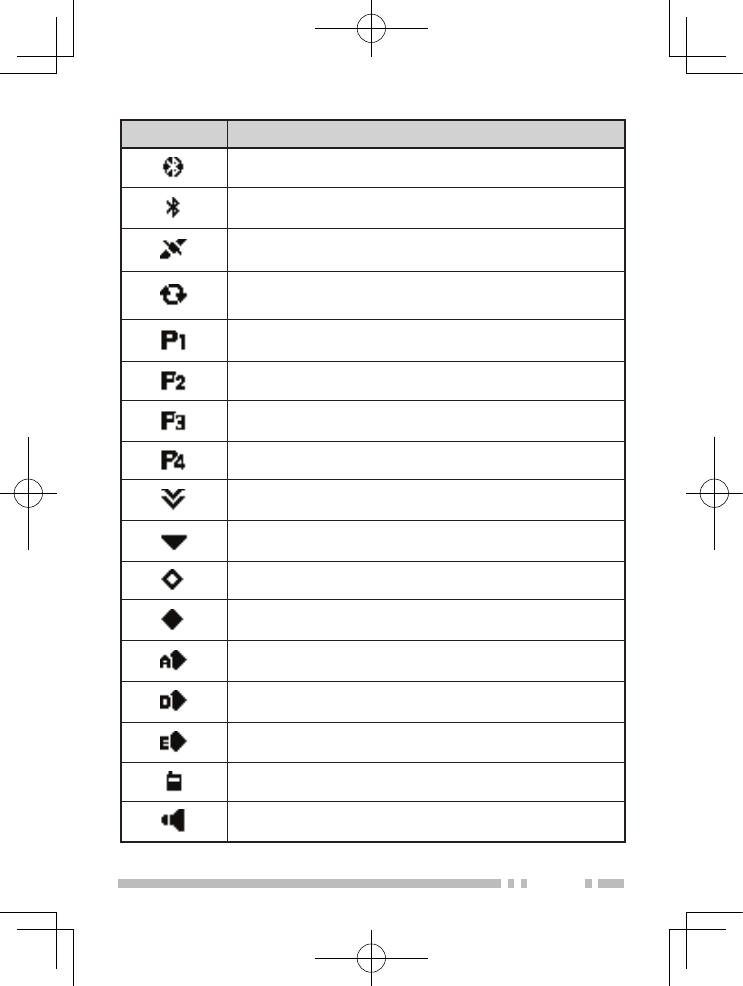
23
Indicator Description
Connected to Bluetooth device.
The Bluetooth function is activated. Blinks in the
process of turning on Bluetooth.
The GPS position is determined. Blinks when the GPS
is unable to determine the position.
Scan, Priority Scan or Voting/Site Roaming is in
progress. Blinks when the scan is paused.
Indicates Priority channel 1 or Priority Monitor ID 1.
Indicates Priority channel 2 or Priority Monitor ID 2.
Indicates Priority Monitor ID 3.
Indicates Priority Monitor ID 4.
The current channel is added to the scanning
sequence.
The current Zone is added to the Multi-Zone scanning
sequence.
The Scrambler function is activated.
The Encryption function is activated. Blinks when
receiving an encrypted carrier.
The Encryption (AES) function is activated. Blinks
when receiving an encrypted carrier.
The Encryption (DES) function is activated. Blinks
when receiving an encrypted carrier.
The Encryption (ARC4) function is activated. Blinks
when receiving an encrypted carrier.
The Talk Around function is activated.
The Monitor or Squelch Off function is activated.
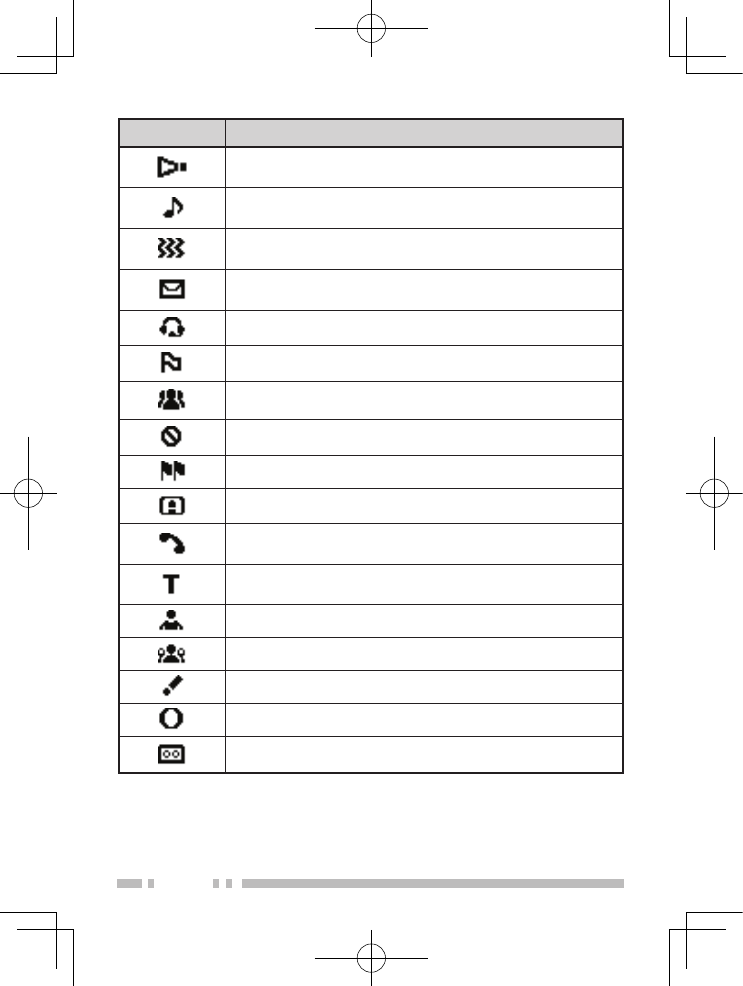
24
Indicator Description
The External Speaker is activated.
Blinks when an incoming call matches your Optional
Signaling.
The Vibrator function is activated. Blinks when the
Vibrator is not functioning.
A message is stored in the memory. Blinks when a
new message is received.
The VOX function is activated.
The Site Lock function is activated.
The Broadcast Call function is activated.
The Surveillance function is activated.
The System Lock function is activated.
The auxiliary port is activated.
Appears when the selected group is programmed as
telephone IDs.
The Tactical Zone is activated.
The Lone Worker function is activated.
The OVCM function is activated.
The Activity Detection function is activated.
The Operator Selectable Tone function is activated.
Blinks during Auto Recording.

25
BasiC oPerations
sWitChinG PoWer on/ oFF
Turn the Power switch/ Volume control clockwise to switch the
transceiver power ON.
Turn the Power switch/ Volume control counter-clockwise to
switch the transceiver power OFF.
aDJUstinG the voLUMe
rotate the Power switch/ Volume control to adjust the volume.
seLeCtinG a Zone anD ChanneL
1 Select the desired zone using the Selector or 4-way D-pad
or the buttons programmed as [Zone Up]/ [Zone Down].
Each zone contains a group of channels.
2 Select the desired channel using the Selector or 4-way
D-pad or the buttons programmed as [Channel Up]/
[Channel Down]. Each channel is programmed with
settings for transmitting and receiving.
•The default setting for the Selector is [Channel Select].
• The transceivers may have names programmed for zones and
channels. The zone name and channel name can contain up to
12 and 14 characters respectively. While selecting a zone, the
zone name will appear above the channel name.
•If programmed by your dealer, your transceiver will announce the
zone and channel numbers as you change them.

26
transMittinG
1 Select the desired zone and channel using the Selector
or 4-way D-pad and the [Zone up]/ [Zone Down] or
[Channel up]/ [Channel Down] buttons.
2 Press the PTT switch and speak into the microphone.
Release the PTT switch to receive.
•The LED indicator lights red while transmitting and green while
receiving a signal. This indicator can also be disabled by
your dealer.
•For best sound quality at the receiving station, hold the
microphone approximately 3 cm to 4 cm (1.5 inches) from your
mouth.
reCeivinG
Select the desired zone and channel. If signaling has been
programmed on the selected channel, you will hear a call only
if the received signal matches your transceiver settings.

27
inForMation on soFtWare LiCense
This transceiver uses a software according to the following license agreements.
*zlib LICENSE
Copyright (C) 1995-2013 Jean-loup Gailly and Mark Adler
This software is provided 'as-is', without any express or implied warranty.
In no event will the authors be held liable for any damages arising from the use of
this software.
Permission is granted to anyone to use this software for any purpose, including
commercial applications, and to alter it and redistribute it freely, subject to the
following restrictions:
1. The origin of this software must not be misrepresented; you must not claim
that you wrote the original software. If you use this software in a product, an
acknowledgment in the product documentation would be appreciated but is
not required.
2. Altered source versions must be plainly marked as such, and must not be
misrepresented as being the original software.
3. This notice may not be removed or altered from any source distribution.
Jean-loup Gailly (jloup@gzip.org)
Mark Adler (madler@alumni.caltech.edu)
*libpng LICENSE
This copy of the libpng notices is provided for your convenience. In case of any
discrepancy between this copy and the notices in the file png.h that is included in
the libpng distribution, the latter shall prevail.
COPYRIGHT NOTICE, DISCLAIMER, and LICENSE:
If you modify libpng you may insert additional notices immediately following this
sentence.
This code is released under the libpng license. libpng versions 1.2.6, August 15,
2004, through 1.6.8, December 19, 2013, are Copyright (c) 2004, 2006-2013
Glenn Randers-Pehrson, and are distributed according to the same disclaimer
and license as libpng-1.2.5 with the following individual added to the list of
Contributing Authors
Cosmin Truta
libpng versions 1.0.7, July 1, 2000, through 1.2.5 - October 3, 2002, are Copyright
(c) 2000-2002 Glenn Randers-Pehrson, and are distributed according to the
same disclaimer and license as libpng-1.0.6 with the following individuals added
to the list of Contributing Authors

28
Simon-Pierre Cadieux
Eric S. Raymond
Gilles Vollant
and with the following additions to the disclaimer:
There is no warranty against interference with your enjoyment of the library
or against infringement. There is no warranty that our efforts or the library will
fulfill any of your particular purposes or needs. This library is provided with all
faults, and the entire risk of satisfactory quality, performance, accuracy, and
effort is with the user.
libpng versions 0.97, January 1998, through 1.0.6, March 20, 2000, are Copyright
(c) 1998, 1999 Glenn Randers-Pehrson, and are distributed according to the
same disclaimer and license as libpng-0.96, with the following individuals added
to the list of Contributing Authors:
Tom Lane
Glenn Randers-Pehrson
Willem van Schaik
libpng versions 0.89, June 1996, through 0.96, May 1997, are Copyright (c) 1996,
1997 Andreas Dilger Distributed according to the same disclaimer and license as
libpng-0.88, with the following individuals added to the list of Contributing Authors:
John Bowler
Kevin Bracey
Sam Bushell
Magnus Holmgren
Greg Roelofs
Tom Tanner
libpng versions 0.5, May 1995, through 0.88, January 1996, are Copyright (c)
1995, 1996 Guy Eric Schalnat, Group 42, Inc.
For the purposes of this copyright and license, “Contributing Authors” is defined
as the following set of individuals:
Andreas Dilger
Dave Martindale
Guy Eric Schalnat
Paul Schmidt
Tim Wegner
The PNG Reference Library is supplied “AS IS”. The Contributing Authors and
Group 42, Inc. disclaim all warranties, expressed or implied, including, without
limitation, the warranties of merchantability and of fitness for any purpose. The
Contributing Authors and Group 42, Inc. assume no liability for direct, indirect,
incidental, special, exemplary, or consequential damages, which may result from
the use of the PNG Reference Library, even if advised of the possibility of such
damage.

29
Permission is hereby granted to use, copy, modify, and distribute this source
code, or portions hereof, for any purpose, without fee, subject to the following
restrictions:
1. The origin of this source code must not be misrepresented.
2. Altered versions must be plainly marked as such and must not be
misrepresented as being the original source.
3. This Copyright notice may not be removed or altered from any source or
altered source distribution.
The Contributing Authors and Group 42, Inc. specifically permit, without fee,
and encourage the use of this source code as a component to supporting the
PNG file format in commercial products. If you use this source code in a product,
acknowledgment is not required but would be appreciated.
A “png_get_copyright” function is available, for convenient use in “about” boxes
and the like:
printf("%s",png_get_copyright(NULL));
Also, the PNG logo (in PNG format, of course) is supplied in the files
“pngbar.png” and “pngbar.jpg” (88x31) and “pngnow.png” (98x31).
Libpng is OSI Certified Open Source Software. OSI Certified Open Source is a
certification mark of the Open Source Initiative.
Glenn Randers-Pehrson
glennrp at users.sourceforge.net
December 19, 2013
*Md5
Copyright (C) 1999, 2000, 2002 Aladdin Enterprises. All rights reserved.
This software is provided 'as-is', without any express or implied warranty.
In no event will the authors be held liable for any damages arising from the use of
this software.
Permission is granted to anyone to use this software for any purpose, including
commercial applications, and to alter it and redistribute it freely, subject to the
following restrictions:
1. The origin of this software must not be misrepresented; you must not claim
that you wrote the original software. If you use this software in a product, an
acknowledgment in the product documentation would be appreciated but is
not required.
2. Altered source versions must be plainly marked as such, and must not be
misrepresented as being the original software.
3. This notice may not be removed or altered from any source distribution.
L. Peter Deutsch
ghost@aladdin.com

© 2017